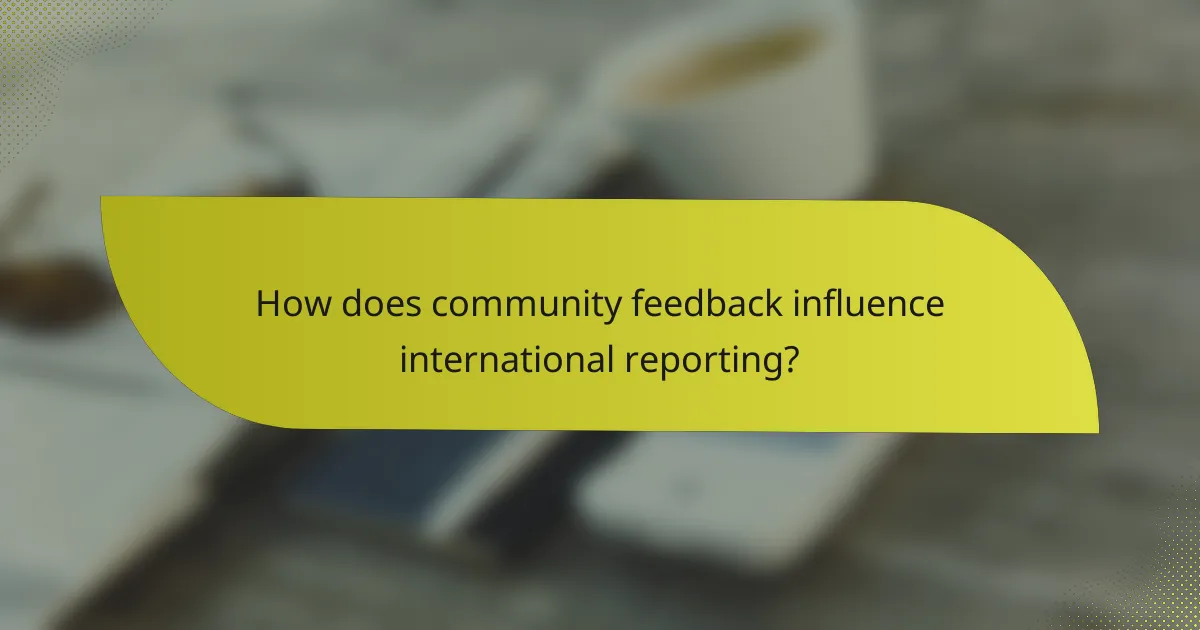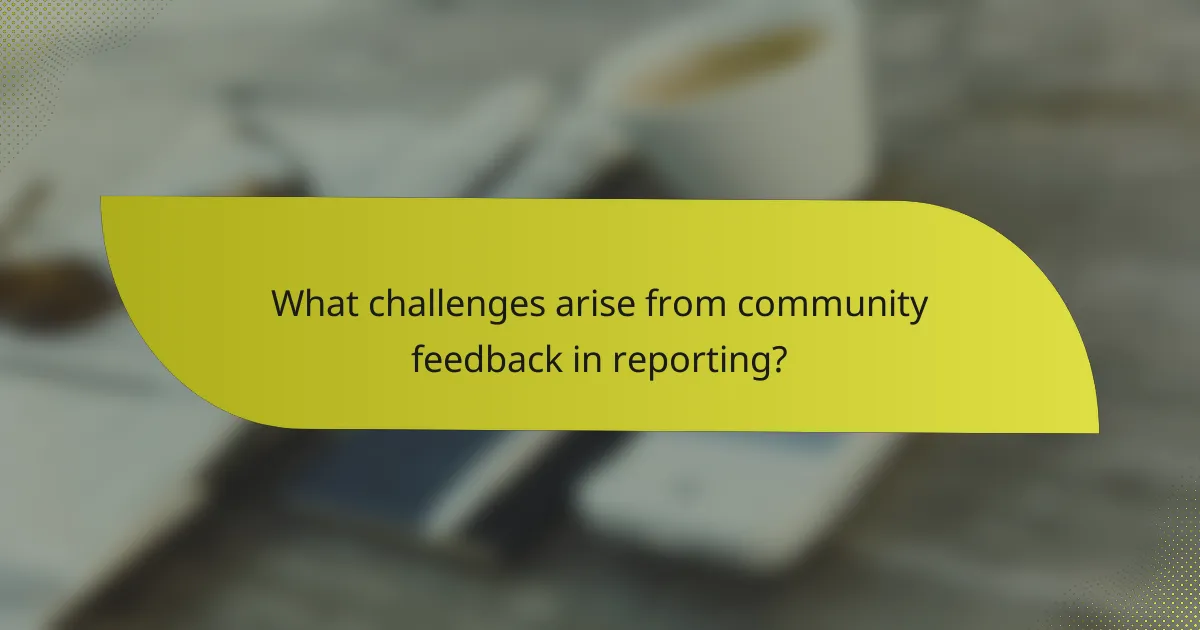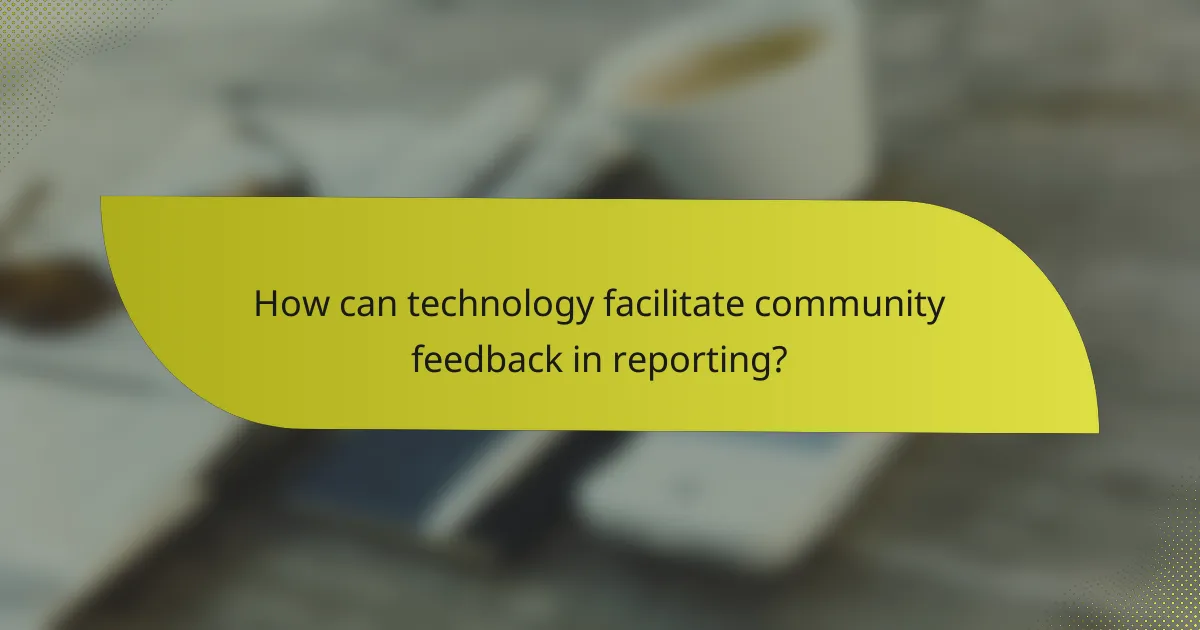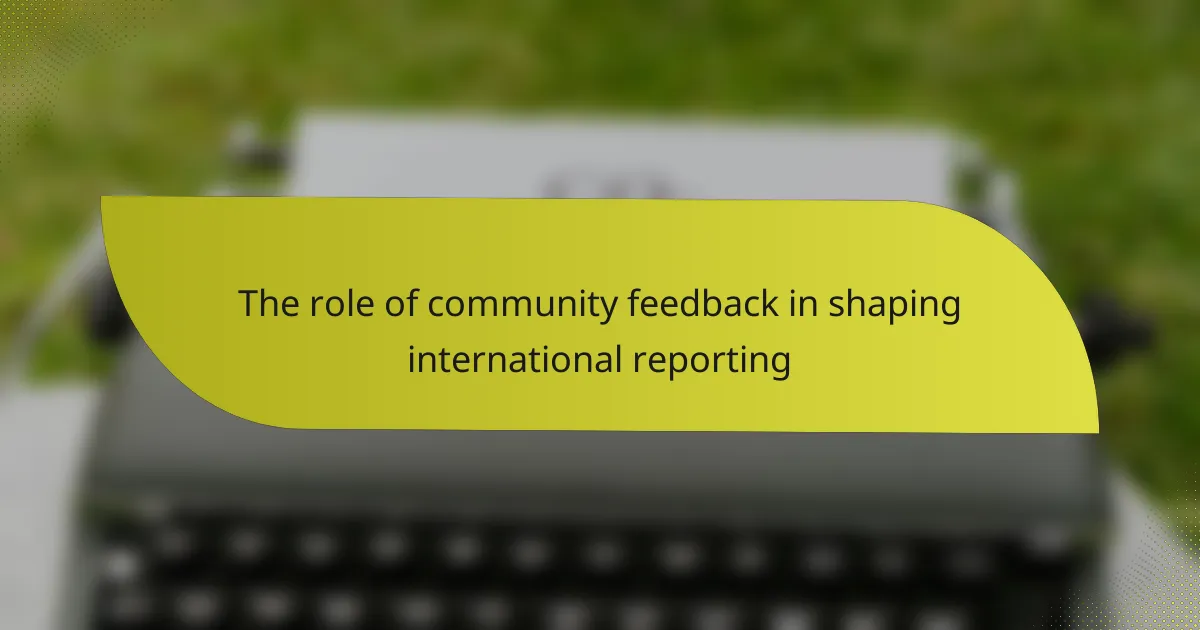Community feedback is essential in shaping international reporting, as it provides valuable insights that enhance the accuracy and relevance of the information shared. By understanding diverse perspectives, reporters can ensure their coverage resonates with a global audience, ultimately fostering a more informed public discourse.

How does community feedback influence international reporting?
Community feedback plays a crucial role in shaping international reporting by providing insights that enhance the accuracy and relevance of the information presented. It allows reporters to understand diverse perspectives, ensuring that their coverage resonates with a global audience.
Enhances accuracy of information
Community feedback helps journalists verify facts and correct inaccuracies in their reporting. When local voices highlight discrepancies or provide additional context, it leads to more precise and reliable news coverage. For instance, a report on a political event may be enriched by firsthand accounts from residents, ensuring that the narrative reflects the actual situation.
Moreover, incorporating feedback can help identify biases in reporting, prompting journalists to present a more balanced view. This is particularly important in international contexts where cultural nuances can significantly affect interpretation.
Increases audience engagement
Engaging with community feedback fosters a sense of ownership among readers and viewers, making them feel valued in the reporting process. When audiences see their comments and suggestions reflected in articles or broadcasts, they are more likely to remain invested in the content. This can lead to increased viewership and readership over time.
Additionally, interactive platforms that allow for real-time feedback, such as social media or comment sections, can create dynamic discussions around international issues. This engagement not only enriches the content but also builds a loyal audience base.
Shapes editorial decisions
Community feedback can significantly influence editorial decisions, guiding what topics are covered and how they are approached. Editors often analyze feedback trends to identify emerging issues that resonate with their audience, ensuring that their reporting remains relevant and timely.
For example, if a particular international crisis garners significant community interest, editors may prioritize coverage of that event, allocating more resources to provide in-depth analysis. This responsiveness to audience needs can enhance the credibility and trustworthiness of the news organization.

What are the best practices for incorporating community feedback?
Incorporating community feedback effectively involves actively engaging with audiences through various channels to gather insights and opinions. Best practices include utilizing social media, conducting surveys, and hosting community forums to ensure diverse perspectives are considered.
Utilize social media platforms
Social media platforms are powerful tools for gathering community feedback due to their wide reach and interactive nature. Engaging with users through posts, polls, and direct messages allows organizations to capture real-time reactions and opinions.
Consider using platforms like Twitter, Facebook, or Instagram to create dedicated posts asking for feedback on specific topics. Regularly monitoring comments and messages can help identify trends and areas for improvement.
Conduct surveys and polls
Surveys and polls provide structured ways to collect community feedback, allowing for quantitative analysis of opinions. These tools can be distributed via email, social media, or embedded on websites to reach a broader audience.
When designing surveys, keep questions clear and concise, and consider offering incentives for participation, such as gift cards or discounts. Aim for a response rate of at least 10-20% to ensure the data is representative of the community.
Host community forums
Hosting community forums creates a space for open dialogue and deeper discussions about specific issues. These events can be held in-person or virtually, allowing for greater accessibility and participation.
To maximize engagement, promote the forum in advance and provide a clear agenda. Encourage attendees to share their thoughts and experiences, and consider recording sessions for those unable to attend. Follow up with a summary of key points and action items to demonstrate that feedback is valued and acted upon.

Which organizations excel in leveraging community feedback?
Several organizations are notable for effectively utilizing community feedback to enhance their international reporting. These entities actively engage with their audiences, incorporating insights and suggestions to improve content relevance and accuracy.
BBC World Service
The BBC World Service has established a robust framework for gathering community feedback, primarily through social media platforms and audience surveys. By analyzing listener responses, they can tailor their programming to better reflect the interests and concerns of diverse global audiences.
For example, the BBC often conducts polls on current events, allowing listeners to express their views and influence coverage priorities. This approach not only fosters engagement but also ensures that reporting resonates with the audience’s realities.
Al Jazeera
Al Jazeera excels in leveraging community feedback by actively encouraging viewer interaction through comments and social media discussions. Their digital platforms facilitate real-time engagement, allowing audiences to voice their opinions on news stories and suggest topics for future coverage.
This feedback loop helps Al Jazeera to remain responsive to the needs of its viewers, ensuring that their reporting is both timely and relevant. They often highlight viewer comments in broadcasts, creating a sense of community and shared dialogue.
Reuters
Reuters utilizes community feedback through its “Reuters Connect” platform, which allows clients and users to provide input on content preferences and reporting styles. This direct line of communication helps Reuters to refine its offerings based on user insights.
Additionally, Reuters conducts regular feedback sessions with journalists and editors to discuss audience reactions and adjust reporting strategies accordingly. This commitment to audience engagement ensures that their international reporting remains credible and aligned with public interests.

What challenges arise from community feedback in reporting?
Community feedback can introduce several challenges in reporting, including the risk of misinformation, bias in interpreting feedback, and the need for adequate resource allocation to manage responses effectively. These factors can complicate the accuracy and reliability of international reporting.
Potential for misinformation
Community feedback can sometimes lead to the spread of misinformation, especially if unverified claims are shared widely. Reporters must be vigilant in distinguishing between credible feedback and false narratives that can skew public perception.
For instance, a single misleading comment can gain traction and influence the overall understanding of an issue, potentially leading to misinformed conclusions in reporting. Establishing clear verification processes for community input is essential to mitigate this risk.
Bias in feedback interpretation
Interpreting community feedback can be subjective, leading to potential biases that affect reporting. Different stakeholders may have varying perspectives, which can color how feedback is understood and utilized.
To counteract bias, reporters should strive for a balanced approach by considering diverse viewpoints and ensuring that feedback is analyzed within a broader context. This helps maintain objectivity and enhances the credibility of the reporting.
Resource allocation for feedback management
Effectively managing community feedback requires significant resources, including time, personnel, and technology. Organizations must allocate adequate staff to monitor, analyze, and respond to feedback to ensure it is integrated into reporting processes.
Setting up a dedicated team or utilizing software tools can streamline feedback management, allowing for quicker responses and better integration of community insights. However, organizations should weigh the costs against the potential benefits of enhanced reporting quality.

How can technology facilitate community feedback in reporting?
Technology plays a crucial role in enabling community feedback in reporting by providing platforms and tools that streamline communication and analysis. These innovations allow journalists to gather insights, gauge public sentiment, and enhance the overall quality of their reporting.
Feedback analysis tools
Feedback analysis tools help journalists collect and interpret community responses to their reports. These tools can aggregate comments from social media, emails, and surveys, allowing reporters to identify trends and common concerns. Utilizing such tools can lead to more informed reporting that reflects the audience’s perspective.
Examples of popular feedback analysis tools include SurveyMonkey for surveys and Hootsuite for social media monitoring. By using these platforms, reporters can efficiently manage large volumes of feedback and prioritize issues that resonate with their audience.
Real-time reporting platforms
Real-time reporting platforms enable journalists to share updates and receive immediate feedback from the community. These platforms, such as Twitter and Facebook Live, allow for instant interaction, fostering a dialogue between reporters and their audience. This immediacy can enhance transparency and trust in the reporting process.
When using real-time platforms, journalists should actively engage with their audience by responding to comments and questions. This interaction not only builds rapport but also provides valuable insights that can shape future reporting efforts.
AI-driven sentiment analysis
AI-driven sentiment analysis tools analyze community feedback to determine the overall sentiment towards specific reports or topics. These tools utilize natural language processing to categorize feedback as positive, negative, or neutral, providing journalists with a clearer understanding of public opinion.
Implementing sentiment analysis can help reporters identify potential biases in their coverage and adjust their narratives accordingly. Tools like Lexalytics and MonkeyLearn offer accessible solutions for media organizations looking to integrate sentiment analysis into their workflow.

What are the future trends in community feedback for international reporting?
Future trends in community feedback for international reporting indicate a shift towards more interactive and transparent communication methods. As digital platforms evolve, they will increasingly facilitate real-time engagement between communities and reporters, enhancing the quality and relevance of international news coverage.
Increased reliance on digital platforms
The move towards digital platforms is reshaping how community feedback is gathered and utilized in international reporting. Social media, online forums, and dedicated feedback applications allow for immediate responses from audiences, providing reporters with insights that can be integrated into their stories.
For instance, platforms like Twitter and Facebook enable journalists to gauge public sentiment and gather diverse perspectives quickly. This shift not only enhances the depth of reporting but also encourages a more inclusive approach to news coverage, reflecting a wider array of voices and experiences.
Greater emphasis on transparency
Transparency is becoming a cornerstone of effective international reporting, driven by community feedback mechanisms. Audiences increasingly demand clarity about sources, methodologies, and potential biases in reporting, prompting journalists to adopt more open practices.
For example, news organizations may publish detailed explanations of their reporting processes or engage in public discussions about editorial choices. This not only builds trust with audiences but also encourages constructive feedback, leading to improved reporting standards and accountability.
